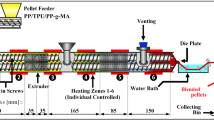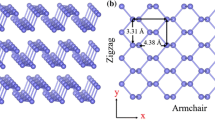Abstract
Nanoparticles are increasingly being used to improve the friction and wear performance of polymers. In this study, we investigated the tribological behavior and energy dissipation characteristics of nano-Al2O3-reinforced polytetrafluoroethylene-polyphenylene sulfide (PTFE-PPS) composites in a sliding system. The tribological behaviors of the composites were evaluated under different normal loads (100–300 N) at a high linear velocity (2 m/s) using a block-on-ring tester. Addition of the nano-Al2O3 filler improved the antiwear performance of the PTFE-PPS composites, and the friction coefficient increased slightly. The lowest wear rate was obtained when the nano-Al2O3 content was 3% (volume fraction). Further, the results indicated a linear correlation between wear and the amount of energy dissipated, even though the wear mechanism changed with the nano-Al2O3 content, independent of the normal load applied.
Similar content being viewed by others
References
ARCHARD J F. Contact and rubbing of flat surfaces [J]. Journal of Applied Physics, 1953, 24(8): 981–988.
MULHEARN T O, SAMUELS L E. The abrasion of metals: A model of the process [J]. Wear, 1962, 5(6): 478–498.
RABINOWICZ E, MUTIS A. Effect of abrasive particle size on wear [J]. Wear, 1965, 8(5): 381–390.
RIGNEY D A. Fundamentals of friction and wear of materials [C]// The 1980 ASM Materials Science Seminar. Pittsburgh, Pennsylvania: American Society for Metals, 1981.
MATVEEVSKY R M. The critical temperature of oil with point and line contact machines [J]. Journal of Basic Engineering, 1965, 87(3): 754–759.
MOHRBACHER H, BLANPAIN B, CELIS J P, ROOS J R. The influence of humidity on the fretting behaviour of PVD TiN coatings [J]. Wear, 1995, 180(1): 43–52.
MOHRBACHER H, BLANPAIN B, CELIS J P, ROOS J R, STALS L, VAN STAPPEN M. Oxidational wear of TiN coatings on tool steel and nitrided tool steel in unlubricated fretting [J]. Wear, 1995, 188(1): 130–137.
HUQ M Z, CELIS J P. Expressing wear rate in sliding contacts based on dissipated energy [J]. Wear, 2002, 252(5): 375–383.
FOUVRY S, KAPSA P. An energy description of hard coating wear mechanisms [J]. Surface and Coatings Technology, 2001, 138(2): 141–148.
FOUVRY S, KAPSA P, ZAHOUANI H, VINCENT L. Wear analysis in fretting of hard coatings through a dissipated energy concept [J]. Wear, 1997, 203: 393–403.
JAHANGIRI M, HASHEMPOUR M, RAZAVIZADEH H, REZAIE H R. A new method to investigate the sliding wear behaviour of materials based on energy dissipation: W–25% Cu composite [J]. Wear, 2012, 274: 175–182.
JAHANGIRI M, HASHEMPOUR M, RAZAVIZADEH H, REZAIE H R. Application and conceptual explanation of an energy-based approach for the modelling and prediction of sliding wear [J]. Wear, 2012, 274: 168–174.
COLACO R, GISPERT M P, SERRO A P, SARAMAGO B. An energy-based model for the wear of UHMWPE [J]. Tribology Letters, 2007, 26(2): 119–124.
SMERDOVA O, MAZUYER D, CAYER-BARRIOZ J. Links between energy dissipation and wear mechanisms in solid epoxy/ epoxy sliding contact [J]. Tribology International, 2014, 77: 148–159.
RENFREW M M, LEWIS E E. Polytetrafluoroethylene. Heat resistant, chemically inert plastic [J]. Industrial & Engineering Chemistry, 1946, 38(9): 870–877.
FLITNEY R K. Seals and sealing handbook [M]. Elsevier, 2011.
LUO Wen-bo, XIAO Hua-ming, TAN Jiang-hua, WU Guo-zhong, LIN Ming-li. Effects of gamma irradiation and moisture absorption on mechanical properties of PA6/PTFE blends [J]. Journal of Central South University of Technology, 2008, 15: 560–563.
BURRIS D L, SAWYER W G. Tribological sensitivity of PTFE/ alumina nanocomposites to a range of traditional surface finishes [J]. Tribology Transactions, 2005, 48(2): 147–153.
BURRIS D L, SAWYER W G. Improved wear resistance in alumina- PTFE nanocomposites with irregular shaped nanoparticles [J]. Wear, 2006, 260(7): 915–918.
LI Fei, HU Ke-ao, LI Jian-lin, ZHAO Bin-yuan. The friction and wear characteristics of nanometer ZnO filled polytetrafluoroethylene [J]. Wear, 2001, 249(10): 877–882.
SCHWARTZ C J, BAHADUR S. Studies on the tribological behavior and transfer film–counterface bond strength for polyphenylene sulfide filled with nanoscale alumina particles [J]. Wear, 2000, 237(2): 261–273.
WANG Yue, GONG Jun, YANG Dong-ya, GAO Gui, REN Jun-fang, MU Bo, CHEN Sheng-sheng, WANG Hong-gang. Tribological Behavior of nano-Al2O3-reinforced PPS-PTFE composites [J]. Tribology Transactions, 2014, 57(2): 173–181.
Handbook of analytic computational methods in applied mathematics [M]. CRC Press, 2000.
Author information
Authors and Affiliations
Corresponding authors
Additional information
Foundation item: Project(51165022) supported by the National Natural Science Foundation of China; Project(20122117) supported by the Lanzhou Science and Technology Bureau Foundation, China; Project(1310RJZA036) supported by the Natural Science Foundation of Gansu Province, China
Rights and permissions
About this article
Cite this article
Cao, Wh., Gong, J., Yang, Dy. et al. Tribological behavior and energy dissipation characteristics of nano-Al2O3-reinforced PTFE-PPS composites in sliding system. J. Cent. South Univ. 24, 2001–2009 (2017). https://doi.org/10.1007/s11771-017-3609-3
Received:
Accepted:
Published:
Issue Date:
DOI: https://doi.org/10.1007/s11771-017-3609-3




